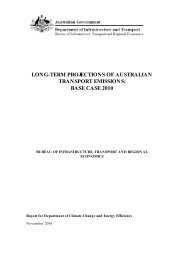Implications of Climate Change for Australia's World Heritage ...
Implications of Climate Change for Australia's World Heritage ...
Implications of Climate Change for Australia's World Heritage ...
You also want an ePaper? Increase the reach of your titles
YUMPU automatically turns print PDFs into web optimized ePapers that Google loves.
IMPLICATIONS OF CLIMATE CHANGE FOR AUSTRALIA’S WORLD HERITAGE PROPERTIES: A PRELIMINARY ASSESSMENT<br />
Cultural and natural heritage are defined in Articles 1 and 2 <strong>of</strong> the <strong>World</strong> <strong>Heritage</strong> Convention. Under Article 1, ‘cultural<br />
heritage’ is considered to comprise:<br />
• monuments: architectural works, works <strong>of</strong> monumental sculpture and painting, elements or structures <strong>of</strong> an<br />
archaeological nature, inscriptions, cave dwellings, and combinations <strong>of</strong> features, which are <strong>of</strong> outstanding universal value<br />
from the point <strong>of</strong> view <strong>of</strong> history, art or science<br />
• groups <strong>of</strong> buildings: groups <strong>of</strong> separate or connected buildings which—because <strong>of</strong> their architecture, their homogeneity or<br />
their place in the landscape—are <strong>of</strong> outstanding universal value from the point <strong>of</strong> view <strong>of</strong> history, art or science<br />
• sites: works <strong>of</strong> humans or the combined works <strong>of</strong> nature and <strong>of</strong> humans, and areas including archaeological sites that are<br />
<strong>of</strong> outstanding universal value from the historical, aesthetic, ethnological or anthropological points <strong>of</strong> view.<br />
Under Article 2, ‘natural heritage’ is defined as:<br />
• natural features consisting <strong>of</strong> physical and biological <strong>for</strong>mations or groups <strong>of</strong> such <strong>for</strong>mations, which are <strong>of</strong> outstanding<br />
universal value from the aesthetic or scientific point <strong>of</strong> view<br />
• geological and physiographic <strong>for</strong>mations, and precisely delineated areas, which constitute the habitat <strong>of</strong> threatened<br />
species <strong>of</strong> animals and plants <strong>of</strong> outstanding universal value from the point <strong>of</strong> view <strong>of</strong> science or conservation<br />
• natural sites or precisely delineated natural areas <strong>of</strong> outstanding universal value from the point <strong>of</strong> view <strong>of</strong> science,<br />
conservation or natural beauty [our emphasis].<br />
Properties nominated <strong>for</strong> <strong>World</strong> <strong>Heritage</strong> status have their values assessed against UNESCO’s 10 criteria, explained in the<br />
Operational Guidelines <strong>for</strong> the Implementation <strong>of</strong> the <strong>World</strong> <strong>Heritage</strong> Convention. 2<br />
Examples <strong>of</strong> UNESCO’s criteria to be listed on the basis <strong>of</strong> natural significance include: ‘… outstanding examples<br />
representing significant on-going ecological and biological processes in the evolution and development <strong>of</strong> terrestrial, fresh<br />
water, coastal and marine ecosystems and communities <strong>of</strong> plants and animals’ and ‘… outstanding examples representing<br />
major stages <strong>of</strong> earth’s history, including the record <strong>of</strong> life, significant on-going geological processes in the development <strong>of</strong><br />
land<strong>for</strong>ms, or significant geomorphic or physiographic features’.<br />
Similarly, UNESCO’s criteria <strong>for</strong> listing on the basis <strong>of</strong> cultural significance apply to six Australian <strong>World</strong> <strong>Heritage</strong> sites. Three<br />
sites have unique <strong>World</strong> <strong>Heritage</strong> cultural values exhibiting ‘an important interchange <strong>of</strong> human values, over a span <strong>of</strong> time<br />
or within a cultural area <strong>of</strong> the world, on developments in architecture or technology, monumental arts, town-planning or<br />
landscape design’ (e.g. the Royal Exhibition Building and Carlton Gardens in Melbourne) and ‘unique artistic achievement<br />
and a masterpiece <strong>of</strong> the creative genius’ (e.g. Sydney Opera House and Aboriginal rock art in Kakadu National Park).<br />
The criteria <strong>for</strong> listing are regularly revised by the <strong>World</strong> <strong>Heritage</strong> Committee to reflect the evolution <strong>of</strong> the <strong>World</strong> <strong>Heritage</strong><br />
concept. Until the end <strong>of</strong> 2004, <strong>World</strong> <strong>Heritage</strong> sites were selected on the basis <strong>of</strong> six cultural and four natural criteria–<br />
whereas now only one set <strong>of</strong> ten criteria exists (UNESCO 2009). As a result, criteria <strong>for</strong> which many sites were originally<br />
inscribed on the <strong>World</strong> <strong>Heritage</strong> List differ from those used in this publication, which uses the current <strong>World</strong> <strong>Heritage</strong><br />
selection criteria.<br />
A more detailed list <strong>of</strong> UNESCO’s criteria is summarised in Table 1. Table 2 lists Australia’s <strong>World</strong> <strong>Heritage</strong> properties against<br />
their respective listing criteria or criterion.<br />
2 <br />
5






